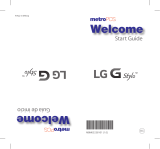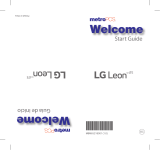
3
Remove back case
Insert Nano SIM Card
This Device supports 2 Nano SIM Cards
Remove back case
Insert Battery
Charging Battery
Printed In Argentina
Earphones
Vol+ Vol-
Power
Before you start using the
Device for the first time you
must charge the battery
for 6 hours at least
SIM 2
SIM
MICRO SD
SIM 2
SIM 1
MICRO SD
Please use only your hands to open the back case
(no tools of any kind). Please find a slot in the botton
right corner for this purpuse
FCC Statement
1. This device complies with Part 15 of the FCC Rules.
Operation is subject to the following two conditions:
(1) This device may not cause harmful interference.
(2) This device must accept any interference received,
including interference that may cause undesired
operation.
2. Changes or modifications not expressly approved
by the party responsible for compliance could void
the user's authority to operate the equipment.
NOTE:
This equipment has been tested and found to comply
with the limits for a Class B digital device, pursuant to
Part 15 of the FCC Rules. These limits are designed to
provide reasonable protection against harmful
interference in a residential installation.
This equipment generates uses and can radiate radio
frequency energy and, if not installed and used in
accordance with the instructions, may cause harmful
interference to radio communications. However, there
is no guarantee that interference will not occur in a
particular installation. If this equipment does cause
harmful interference to radio or television reception,
which can be determined by turning the equipment
o and on, the user is encouraged to try to correct
the interference by one or more of the following
measures:
Reorient or relocate the receiving antenna.
Increase the separation between the equipment and
receiver.
Connect the equipment into an outlet on a circuit
dierent from that to which the receiver is connected.
Consult the dealer or an experienced radio/TV
technician for help.
SAR Information Statement
Your wireless phone is a radio transmitter and receiver.
It is designed and manufactured not to exceed the
emission limits for exposure to radiofrequency (RF)
energy set by the Federal Communications Commission
of the U.S. Government. These limits are part of
comprehensive guidelines and establish permitted
levels of RF energy for the general population. The
guidelines are based on standards that were developed
by independent scientific organizations through
periodic and thorough evaluation of scientific studies.
The standards include a substantial safety margin
designed to assure the safety of all persons, regardless
of age and health. The exposure standard for wireless
mobile phones employs a unit of measurement known
as the Specific Absorption Rate, or SAR. The SAR limit
set by the FCC is 1.6 W/kg. * Tests for SAR are
conducted with the phone transmitting at its highest
certified power level in all tested frequency bands.
Although the SAR is determined at the highest certified
power level, the actual SAR level of the phone while
operating can be well below the maximum value. This is
because the phone is designed to operate at multiple
power levels so as to use only the power required to
reach the network. In general, the closer you are to a
wireless base station antenna, the lower the power
output. Before a phone model is available for sale to the
public, it must be tested and certified to the FCC that it
does not exceed the limit established by the
government adopted requirement for safe exposure.
The tests are performed in positions and locations (e.g.,
at the ear and worn on the body) as required by the FCC
for each model. The highest SAR value for this model
phone when tested for use at the ear is 1.057W/Kg and
when worn on the body, as described in this user guide,
is 1.063W/Kg(Body-worn measurements dier among
phone models, depending upon available accessories
and FCC requirements). The maximum scaled SAR in
hotspot mode is1.063W/Kg.While there may be
dierences between the SAR levels of various phones
and at various positions, they all meet the government
requirement for safe exposure. The FCC has granted an
Equipment Authorization for this model phone with
all reported SAR levels evaluated as in compliance with
the FCC RFexposure guidelines. SAR information
on this model phone is on file with the FCC and can be
found under the Display Grant section of
http://www.fcc.gov/ oet/fccid after searching on
FCC ID: 2ALP3-L1PRO Additional information on Specific
Absorption Rates (SAR) can be found on the
Cellular Telecommunications Industry Asso-ciation
(CTIA) web-site at http://www.wow-com.com. * In the
United States and Canada, the SAR limit for mobile
phones used by the public is 1.6 watts/kg (W/kg)
averaged over one gram of tissue. The standard
incorporates a sub-stantial margin of safety to give
additional protection for the public and to account for
any variations in measurements.
Body-wornOperation
This device was tested for typical body-worn
operations. To comply with RF exposure requirements, a
minimum separation distance of 10mm must be
maintained between the user’s body and the handset,
including the antenna. Third-party belt-clips, holsters,
and similar accessories used by this device should not
contain any metallic components. Body-worn
accessories that do not meet these requirements may
not comply with RF exposure requirements and should
be avoided. Use only the supplied or an approved
antenna.
KODAK SMARTWAY L1 PRO
Getting yoy new KODAK SMARTWAY L1 PRO Mobile
Phone means more inspiration and fun. You will be
thrilled using your KODAK SMARTWAY L1 PRO Mobile
Phone to share all your stories!


 1
1
 2
2
Genesis G126 Android 10 (Go edition) Manual de usuario
LG D415 Guía de inicio rápido
Alcatel One Touch Fierce XL - 5055W El manual del propietario
 LG MS MS631 Metro PCS Guía de inicio rápido
LG MS MS631 Metro PCS Guía de inicio rápido
 LG MS MS631 Metro PCS Guía de inicio rápido
LG MS MS631 Metro PCS Guía de inicio rápido
LG Electronics Conference Phone 500G Manual de usuario
Verizon UML295 Manual de usuario
Nokia XR21 Guía del usuario
PCD CDM2030 Manual de usuario



